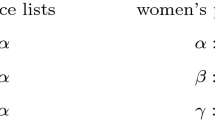Abstract
In this paper a parallel algorithm to solve the stable marriage problem is given. The worst case performance of this algorithm is stated. A theoretical analysis shows that the probability of the occurrence of this worst case is extremely small. For instance, if there are sixteen men and sixteen women involved, then the probability that the worst case occurs is only 10−45. Possible future research is also discussed in this paper.
Similar content being viewed by others
References
L. Allison,Stable marriages by coroutines, Information Processing Letters, Vol. 16, No. 2 (Feb. 1983), 61–65.
J. L. Bentley,Multidimensional Divide-and-conquer, Communications of the ACM, Vol. 23, No. 4, (Apr. 1980), 214–239.
D. Gale and L. S. Shapley,College admissions and the stability of marriage, Am. Math. Monthly 69 (1962), 9–15.
F. S. Hiller and G. J. Lieberman,Introduction to Operations Research, 3rd ed., Holden-Day, San Francisco (1980).
D. G. McVitie and L. B. Wilson,Stable marriage assignment for unequal sets, BIT 10 (1970), 295–309.
D. G. McVitie and L. B. Wilson,The stable marriage problem, Communications of the ACM, Vol. 14, No. 7, (July 1971), 486–490.
D. G. McVitie and L. B. Wilson, Algorithm 411, Pts. 1–3,Three procedures for the stable marriage problem, Communications of the ACM, Vol. 14, No. 7, (July 1971), 491–492.
L. B. Wilson,An analysis of the stable marriage assignment algorithm, BIT 12 (1972), 569–575.
Author information
Authors and Affiliations
Rights and permissions
About this article
Cite this article
Tseng, S.S., Lee, R.C.T. A parallel algorithm to solve the stable marriage problem. BIT 24, 308–316 (1984). https://doi.org/10.1007/BF02136029
Received:
Revised:
Issue Date:
DOI: https://doi.org/10.1007/BF02136029




